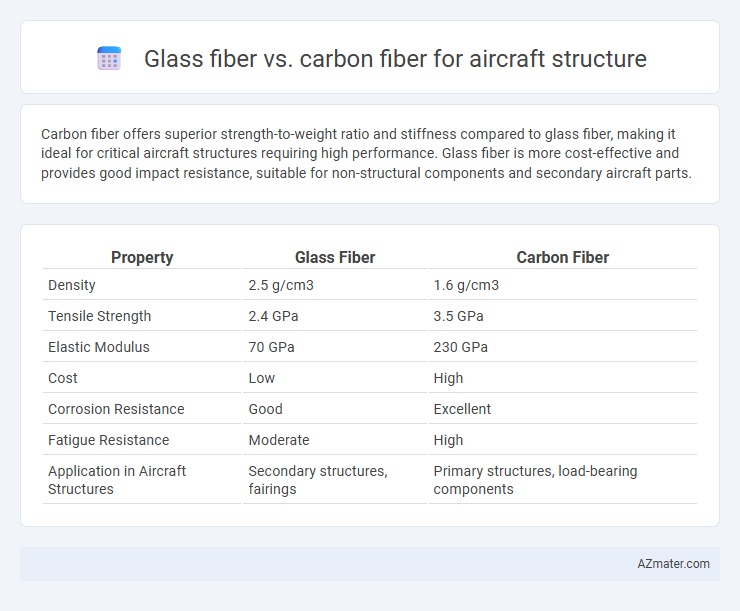Carbon fiber offers superior strength-to-weight ratio and stiffness compared to glass fiber, making it ideal for critical aircraft structures requiring high performance. Glass fiber is more cost-effective and provides good impact resistance, suitable for non-structural components and secondary aircraft parts.
Table of Comparison
| Property | Glass Fiber | Carbon Fiber |
|---|---|---|
| Density | 2.5 g/cm3 | 1.6 g/cm3 |
| Tensile Strength | 2.4 GPa | 3.5 GPa |
| Elastic Modulus | 70 GPa | 230 GPa |
| Cost | Low | High |
| Corrosion Resistance | Good | Excellent |
| Fatigue Resistance | Moderate | High |
| Application in Aircraft Structures | Secondary structures, fairings | Primary structures, load-bearing components |
Introduction to Composite Materials in Aviation
Composite materials in aviation combine fibers like glass and carbon with resin matrices to create lightweight, high-strength structures essential for modern aircraft. Glass fiber offers excellent impact resistance and cost-effectiveness, making it suitable for non-critical airframe components, while carbon fiber provides superior stiffness, strength, and weight reduction critical for primary structural elements. The selection between glass and carbon fiber composites depends on performance requirements, cost constraints, and specific application areas within the aircraft structure.
Overview of Glass Fiber and Carbon Fiber
Glass fiber, composed of fine fibers of glass, offers high tensile strength, excellent corrosion resistance, and cost-effectiveness, making it suitable for non-critical aircraft structures and interior components. Carbon fiber consists of tightly woven carbon fibers known for superior strength-to-weight ratio, stiffness, and fatigue resistance, ideal for primary structural elements in modern aircraft. Comparing both, carbon fiber provides greater performance benefits in weight reduction and structural integrity, while glass fiber remains favored for budget-sensitive applications with moderate mechanical demands.
Material Properties Comparison
Glass fiber offers high tensile strength and excellent flexibility, making it cost-effective and corrosion-resistant for aircraft structures, while carbon fiber provides superior stiffness, higher strength-to-weight ratio, and enhanced fatigue resistance, crucial for optimizing performance and fuel efficiency. Carbon fiber's lower density and higher modulus enable significant weight reduction compared to glass fiber, contributing to improved aerodynamic efficiency and structural integrity in aerospace applications. The thermal stability and impact resistance of carbon fiber also surpass those of glass fiber, making it the preferred choice for critical load-bearing components in modern aircraft design.
Strength-to-Weight Ratio Analysis
Carbon fiber offers a superior strength-to-weight ratio compared to glass fiber, making it the preferred choice for aircraft structures requiring high performance and durability. While glass fiber provides adequate tensile strength at a lower cost, its density and stiffness are significantly less optimized than carbon fiber, resulting in heavier components for equivalent structural integrity. The enhanced tensile strength of carbon fiber enables weight reductions in the aircraft frame, improving fuel efficiency and overall aerodynamic performance.
Durability and Fatigue Resistance
Carbon fiber exhibits superior durability and fatigue resistance compared to glass fiber in aircraft structures, due to its higher tensile strength and stiffness. The enhanced fatigue resistance of carbon fiber reduces the likelihood of micro-crack propagation under cyclic loading, extending the service life of critical components. Glass fiber, while cost-effective and corrosion-resistant, typically shows lower fatigue endurance and may require more frequent inspections and maintenance in demanding aerospace applications.
Cost Implications for Manufacturing
Glass fiber offers significantly lower material and manufacturing costs compared to carbon fiber in aircraft structures, making it a more budget-friendly choice for large-scale production. Carbon fiber, while providing superior strength-to-weight ratio and performance, demands expensive raw materials and energy-intensive processes, increasing overall manufacturing expenses. The choice between the two directly influences aircraft production budgets, with glass fiber favored for cost-efficiency and carbon fiber selected when performance justifies higher expenditure.
Applications in Aircraft Structures
Glass fiber is commonly used in secondary aircraft structures such as fairings, radomes, and interior components due to its cost-effectiveness, corrosion resistance, and good impact strength. Carbon fiber offers superior strength-to-weight ratio and stiffness, making it the preferred material for primary load-bearing components like wings, fuselage frames, and landing gear assemblies. Advanced composites combining carbon fiber are increasingly utilized in modern aircraft to enhance fuel efficiency and performance through weight reduction and increased structural integrity.
Maintenance and Repair Considerations
Glass fiber composites in aircraft structures offer easier and more cost-effective maintenance due to their greater resistance to impact damage and simpler repair techniques compared to carbon fiber. Carbon fiber structures, while providing superior strength-to-weight ratios and stiffness, require specialized repair procedures and equipment, making maintenance more complex and expensive. Inspecting carbon fiber components often involves advanced non-destructive testing methods to detect delamination and fiber breakage, critical for ensuring structural integrity.
Environmental Impact and Sustainability
Glass fiber composites in aircraft structures offer lower environmental impact due to their higher recyclability and cost-effective production methods compared to carbon fiber. Carbon fiber provides superior strength-to-weight ratios, enhancing fuel efficiency and reducing carbon emissions during flight, but its energy-intensive manufacturing and limited recycling options pose sustainability challenges. Optimizing aircraft design with glass fiber can minimize ecological footprints, while carbon fiber advancements in recycling technologies are crucial for sustainable aerospace applications.
Future Trends in Aerospace Composites
Future trends in aerospace composites highlight increasing integration of carbon fiber over glass fiber due to its superior strength-to-weight ratio and enhanced fatigue resistance crucial for aircraft structures. Emerging hybrid composites combine carbon fiber and glass fiber to leverage cost-efficiency alongside high performance, addressing diverse structural demands. Advanced manufacturing techniques such as automated fiber placement and resin transfer molding promote optimized composite layering, enabling lighter, more durable, and more sustainable aerospace components.

Infographic: Glass fiber vs Carbon fiber for Aircraft structure
 azmater.com
azmater.com